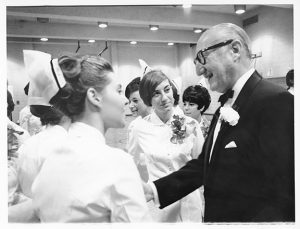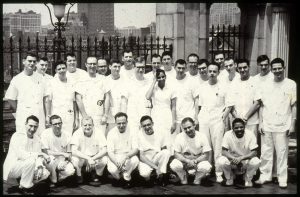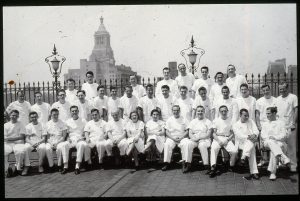Sep 28, 2016
The creation of the Mount Sinai Health System in 2013, formed by the merger of the Mount Sinai Medical Center with Continuum Health Partners, brought some of New York City’s major hospitals together under a single organizational umbrella. The individual hospitals making up the Health System, however, often themselves incorporate multiple hospitals with which they have merged and affiliated over the years. As the Archives continues to collect, process and make available the records of the former Beth Israel Medical Center, we have acquired material relating to various smaller hospitals associated with Beth Israel. The records of these institutions provide a glimpse into the wide variety of small hospitals that existed in New York during the twentieth century.

Doctors Hospital
Doctors Hospital was an exclusive voluntary hospital, founded in 1929 by members of New York City’s social elite, which catered to the needs of wealthy private patients. Its Upper East Side location on East End Avenue overlooked Carl Schurz Park and Gracie Mansion (pictured, at center). In 1987 it became part of the Beth Israel Medical Center and was briefly known as Beth Israel Hospital North before being renamed Beth Israel Medical Center Singer Division. It closed in 2004, and its building was torn down the following year; the site is now occupied by luxury residences. The minutes of the Doctors Hospital Board of Directors, recently discovered in offsite storage associated with Beth Israel, are now a part of the collection of the Mount Sinai Archives.
Jewish Maternity Hospital
The Jewish Maternity Hospital was founded in 1906. Located at 270 Broadway, it provided maternity care to the Lower East Side’s growing community of Eastern European Jewish immigrants. At the urging of the Federation of Jewish Philanthropies, which hoped to consolidate its medical activities during the lean years of the Great Depression, it merged in 1930 with Beth Israel, which had recently moved to a state of the art modern hospital on Stuyvesant Square. For some time the two institutions maintained separate wards within the hospital building, but by the 1940s the Maternity Hospital had been absorbed into the obstetrics department at Beth Israel. Three volumes of its patient registers, dated 1921-1933, are housed in the Mount Sinai Archives.
New York Lying-In Hospital / Manhattan General Hospital
The New York Lying-In Hospital already had a long institutional history, dating back to the yellow fever epidemic of 1798, when it moved in 1902 to a newly built home at 307 2nd Avenue on the northwest corner of Stuyvesant Square. The hospital’s time at this location was a productive one, during which members of the hospital staff pioneered the use of pharmaceutical pain management to ease the pain of childbirth. In 1932 the New York Lying-In Hospital left the site to become the OB-GYN department of the New York Hospital at its campus on the Upper East Side. The building on Stuyvesant Square became home to the proprietary Manhattan General Hospital. In 1965 the building was purchased by Beth Israel and became the Morris J. Bernstein Institute, a pioneering inpatient facility for addiction treatment. The building was sold in 1984 and is now an apartment complex, but its origin as a maternity hospital can still be seen in the elegant sculptures of infants displayed on its facade. The records of the Lying-In Hospital itself are in the Archives of the Weill Cornell Medical College, but the Mount Sinai Archives has a small assortment of records related to the Bernstein Institute during the period that it occupied the former Lying-In Hospital building.
Jan 4, 2024
With a new year upon us, we recognize Mount Sinai’s historical milestones. It grounds us in the knowledge that our predecessors’ relentless efforts resulted in discoveries of what was once thought beyond medicine or science. The achievements of the Icahn School of Medicine at Mount Sinai and the Mount Sinai Health System throughout our histories inspire our work to greater heights.
Compiled by J.E. Molly Seegers, Michala Biondi, and Stefana Breitwieser
1824 – 200 years ago
The New York Eye and Ear Infirmary created its Otology Service, the first in the U.S.
1859 – 165 years ago
The Uterine Service (later renamed the Gynecology Service) was formed at Roosevelt Hospital, the first specialty service outside of the Medical and Surgical departments.
1874 – 150 years ago
New York Eye and Ear Infirmary surgeons began charting detailed accounts of their cases (already customary in Europe).
1884 – 140 years ago
The Mount Sinai Hospital Board of Directors approved the creation of “Outdoor Visiting Physicians” which became the District Medical Service. 111 years later in 1995, the Mount Sinai Visiting Doctors Program took up this mantle by providing care to adults who are unable to leave their homes.
1889 – 135 years ago
On December 1st, the Beth Israel Hospital was formed at the founding meeting of the Beth Israel Hospital Association held at 165 East Broadway. Beth Israel’s first physical location, a dispensary, opened in May 1891 between Henry Street and Madison Street, just underneath the Manhattan Bridge.
Daniel Guggenheim, one of seven sons of Meyer Guggenheim, became a Trustee of Mount Sinai Hospital, beginning a family relationship with the institution that persists today.
1899 – 125 years ago
As a result of the rigorous scientific environment, and so that their work would be “utilized in the interest of medical science and art,” Mount Sinai Hospital began publishing special reports describing various studies, statistics, and case summaries. The first volume was 347 pages.
Mount Sinai Hospital purchased four lots on the Southwest corner of Madison Ave and 101st St to build our third and current location. The cost was $140,000.
Roosevelt Hospital opened The Ward for Sick Children in the Accident building at W. 58th St. and Ninth Avenue. Abraham Jacobi, MD, widely known as the “Father of American pediatrics,” originally assumes charge of the ward. He had been on the staff of the Mount Sinai Hospital since 1860.
The New York Eye and Ear Infirmary’s Board of Directors created a Post-Graduate School for Nurses.
St. Luke’s Hospital established a policy of accepting tuberculosis patients. At the time, patients with “incurable” diseases were not accepted in most hospitals.
The pathology museum was founded at Mount Sinai Hospital.
1909 – 115 years ago
Nettie Shapiro, MD joined the house staff at Beth Israel Hospital, the first female member.
1924 – 100 years ago
All Mount Sinai Hospital
- The Occupational Therapy Department was inaugurated, primarily for outpatient “mental cases.” Separately, a Therapeutic Kindergarten began, akin to today’s pediatric group therapy. Both began under the Social Service Auxiliary.
- Annual Report stated, “intimate contact between the wards of the Hospital and the laboratories exists by virtue of the fact that a large number of the Attending Staff are permanent laboratory associates and assistants.”
- Physicians emphasized “one of the most important developments of modern medicine is the study of end results”; requested unified medical records and “a much more elaborate social service organization” to tabulate and analyze. Foretelling the importance of data science.
- Insulin was first administered for diabetes treatment. Recently introduced radium treatments numbered 2,798.
- The Physiological Chemistry department furnished a trained assistant to take charge of a laboratory recently opened in the pediatric department. This was the first instance of a special research laboratory in one of Mount Sinai Hospital’s clinical departments.
- Gertrude Felshin, MD joined the House Staff. For the next 39 years, she simultaneously held appointments in Pediatrics and Gynecology, as well as working as a Research Assistant in several laboratories: Endocrinology, Chemistry, and Pediatrics. Her work bridged the gap before there were obstetrics or reproductive science services.
- A radiographic museum was created for teaching and studying roentgenograms (x-rays).
- Statistics for the year:
- 22,407 total patients treated in Hospital and Emergency Ward
- 5,837 major surgical operations
- 181,505 consultations in Out-Patient Department
1939 – 85 years ago
St. Luke’s Hospital established the position of Director of Religious Activities. The department was said to have been a model for planning hospital religious departments throughout the country.
1949 – 75 years ago
Mount Sinai Hospital’s Psychiatry Department established an adolescent clinic.
A new clinic to treat congenital heart disease was created at Mount Sinai Hospital.
Roosevelt Hospital established its Division of Psychiatry. New York State invited the Hospital to participate in its Psychiatric Pilot Plan which assigned a psychiatrist to each medical, surgical and specialty division in the hospital and out-patient services for support.
The Poliomyelitis service inaugurated at St. Luke’s Hospital. When NYC’s two contagious diseases hospitals were overwhelmed with patients, St. Luke’s—unique among the city’s voluntary hospitals—accepted and treated the overflow.
1974 – 50 years ago
Mount Sinai Medical Center’s Adolescent Health Center (AHC) was officially opened at 19 E. 101st St as all adolescent services were centralized in one building. It was the largest comprehensive care facility for adolescents in the country.
Mount Sinai Medical Center’s Medical Board amended the by-laws to provide full board membership for the Director of Nursing and the Director of Social Work. Thereby the first women on the Board were Dr. Gail Kuhn Weissman, Director of Nursing, and Dr. Helen Rehr, Director of Social Work.
Division of Neonatology was created by Farrokh Shahrivar, MD at St. Luke’s Hospital.
A private nurse-midwife practice opened at Roosevelt Hospital, ten years after the general nurse-midwife practice was instituted.
St. Luke’s Hospital’s Palliative Care Program was established for terminally ill patients, the majority of whom were cancer patients and later AIDS patients.
St. Luke’s Hospital School of Nursing held its last graduation and closed. During its more than eighty years of existence, over 4,000 women, and a few men, graduated.
1984 – 40 years ago
The Kathryn and Gilbert Miller Health Care Institute for Performing Artists opened at Roosevelt Hospital.
Beth Israel Medical Center created a geriatric psychiatry inpatient program. The New York Eye Trauma Center opened at the New York Eye and Ear Infirmary. Both were the first of their kind in New York City.
The Beth Israel School of Nursing was renamed the Phillips Beth Israel School of Nursing after Seymour Phillips, a member of the School’s Board of Trustees for more than forty years. Members of the Phillips family remain on the Board today.
1989 – 35 years ago
The Peter Krueger Clinic for the Treatment of Immunological Disorders at Beth Israel Medical Center was dedicated on First Ave by Trustee Harvey and Connie Krueger in memory of their son, Peter.
Mount Sinai School of Medicine students first used simulated patients to test clinical practice skills. The School soon received a gift to establish the Charles C., Marietta and Charles A. Morchand Center.
First woman chairman at Mount Sinai School of Medicine, Brenda Shank, MD, Ph.D. was appointed Chairman of Radiotherapy; she changed the department’s name to Radiation Oncology.
In cooperation with The Tokio Marine and Fire Insurance Co. Ltd., Beth Israel Medical Center established a medical service dedicated to Japanese citizens and tourists in the metropolitan area; it included “a bilingual, multidisciplinary medical practice” and was “modeled after Japanese medical protocols” that emphasize preventive medicine and extensive annual examinations.
Both Beth Israel and Mount Sinai were designated as AIDS centers.
1994 – 30 years ago
The Mount Sinai School of Medicine’s Department of Emergency Medicine became operational when Sheldon Jacobson, MD was appointed founding Chairman.
St. Luke’s-Roosevelt Hospital Center opened The Theodore B. Van Itallie Center for Nutrition and Weight Management under the Division of Endocrinology, Metabolism and Nutrition.
Lawrence S. Phillips donated $5 million to name the Zeckendorf Towers’ facility Philips Ambulatory Care Center. The gift commemorated their four generations of service to the Beth Israel Medical Center.
1999 – 25 years ago
Mount Sinai Medical Center purchased Western Queens Community Hospital (formerly Astoria General) for $40 million. With 235 beds, it was renamed The Mount Sinai Hospital of Queens.
Mount Sinai’s Dermatology Department founded the Skin of Color Center, the first of its kind, to focus on the numerous skin conditions which disproportionately affect people of color or require special evaluation techniques and treatments.
The Mount Sinai Medical School’s Department of Preventive Medicine, With the support of the Pew Charitable Trust, established the Center for Children’s Health and the Environment was the “nation’s first academic research and policy center established to examine the links between childhood illness and exposure to toxic pollutants.”
Mount Sinai’s Multidisciplinary Minimally Invasive Surgery Center opened with six operating rooms.
2004 – 20 Years Ago
The East Harlem Health Outreach Partnership (EHHOP) clinic was created by Mount Sinai School of Medicine students. The goal was to provide high quality primary and preventative health care at no cost to uninsured residents of East Harlem.
The New York Eye and Ear Infirmary opened the Jorge N. Buxton, MD, Microsurgical Education Center.
2009 – 15 years ago
Roosevelt Hospital’s Headache Institute launched an Adolescent Headache Medicine Program to provide appropriate diagnosis and care for children suffering from migraines.
St. Luke’s-Roosevelt Hospital Center’s Division of Pulmonary Critical Care and Sleep Medicine and the Department of Rehabilitation Medicine opened the Pulmonary Rehabilitation Maintenance Program.
The American Nurses Credentialing Center re-designated Mount Sinai Hospital as a Magnet Award winning hospital, in recognition of superior nursing performance. It was the first full-service New York hospital to be re-designated.
Mount Sinai School of Medicine received a Clinical and Translational Research Award (CTSA) for $34.6 million. Research was conducted under a new centralized, multi- and interdisciplinary structure known as the Mount Sinai Institutes for Clinical and Translational Sciences (now ConduITS).
New York Eye and Ear Infirmary’s Facial Paralysis Rehabilitation Center opened.
Mount Sinai School of Medicine’s Ph.D. program in Clinical Research enrolled its first students. The master’s program was already ongoing.
2014 – 10 years ago
Mount Sinai West and the Mount Sinai Health System created the Kidney Stone Center offering minimally invasive treatment techniques and a holistic approach to prevention, the first such center in New York City.
The Icahn School of Medicine at Mount Sinai’s chapter of the American Medical Women’s Association (AMWA) held its inaugural meeting.
New York Eye and Ear Infirmary of Mount Sinai was the first in the United States to perform a series of autologous temporalis fascia transplants to the vocal fold to restore patients’ voices.
2019 – 5 years ago
Mount Sinai St. Luke’s and Mount Sinai West announced the creation of a new inpatient Addiction Consultation and Evaluation Service (ACES).
SafetyNet, an electronic adverse event reporting system, launched across the Mount Sinai Health System.
Dean Charney announced the creation of a Center for Biomedical and Population Health Informatics, which was co-sponsored by the Department of Population Health Science and Policy and the Scientific Computing group.
Mount Sinai Health System kicked off the Diversity Innovation Hub to address social determinants of health and representation of women and minorities in health care.
The Icahn School of Medicine at Mount Sinai started the Institute for Transformative Clinical Trials to provide translational and clinical researchers throughout the Health System with the interdisciplinary expertise to design, conduct, and analyze innovative clinical trials.
A new research center, The Lipschultz Center for Cognitive Neuroscience within the Nash Family Department of Neuroscience and The Friedman Brain Institute at the Icahn School of Medicine at Mount Sinai, was created to focus on understanding the neural mechanisms of higher cognitive function and apply this knowledge to the diagnosis and treatment of disorders of cognitive function in humans.







